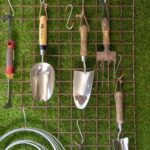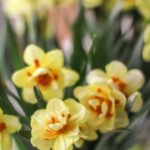Are you looking to create a stunning and vibrant flower garden bed? The key to achieving your desired aesthetic lies in the layout design. Flower garden bed layout designs play a crucial role in maximizing the visual impact of your garden, while also ensuring that the flowers thrive and flourish. From strategic placement to color coordination, each aspect of the layout contributes to the overall beauty of the garden.
When it comes to planning the layout of your flower garden bed, there are several factors to take into consideration. The size and shape of the garden bed, sunlight exposure, soil quality, and even neighboring plant life all play a role in determining the most suitable design for your space. By carefully considering these factors, you can create a layout that not only looks visually appealing but also provides an ideal environment for your flowers to bloom.
In addition to planning the layout, selecting the right flowers is equally important. Different types of flowers have different growth requirements and maintenance needs. Choosing compatible flowers for your garden bed will contribute to its overall health and longevity. Whether you prefer a wild, natural-looking garden or a more structured and formal design, the selection of flowers will greatly impact the final look of your flower bed.
Factors to Consider When Planning Your Flower Garden Bed Layout
When planning the layout of your flower garden bed, there are several important factors to consider in order to ensure a successful and visually appealing design. One of the most crucial factors is the amount of sunlight that your garden bed will receive.
It’s essential to observe and understand the sunlight patterns in your yard before deciding where to place your flower bed. Different flowers have varying sunlight requirements, so take note of which areas receive full sun, partial sun, or shade throughout the day.
Another important factor to consider is the soil quality in the area where you plan to create your flower garden bed. Good soil quality is vital for the health and growth of your flowers. Conduct a soil test to determine its pH level and nutrient content. This will help you understand if any specific amendments are necessary for optimal plant growth.
In addition, it’s essential to consider the overall aesthetic of your garden when planning the layout of your flower bed. Think about how different flowers will complement each other in terms of colors, textures, and heights. You may also want to consider creating focal points within your garden bed by strategically placing taller or more eye-catching flowers in certain areas.
| Factor | Description |
|---|---|
| Amount of Sunlight | Observe sunlight patterns; different flowers have varying sunlight requirements. |
| Soil Quality | Conduct a soil test; determine pH level and nutrient content. |
| Aesthetic Considerations | Think about color coordination, textures, height variations, and creating focal points. |
Choosing the Right Flowers for Your Garden Bed
When it comes to designing your flower garden bed layout, choosing the right flowers is essential to ensure a beautiful and thriving garden. There are a few factors to consider when selecting the perfect flowers for your garden bed.
Climate and Soil
First and foremost, take into account the climate and soil conditions of your garden. Certain flowers thrive in specific climates and soil types, so it’s crucial to choose flowers that are well-suited to your region. Consider factors such as sunlight exposure, temperature, and moisture levels when making your selections.
Color Scheme and Theme
Another important factor to consider when choosing flowers for your garden bed is the color scheme and overall theme you want to achieve. Think about the aesthetic you’re aiming for – whether it be a vibrant and colorful mix of blooms or a more monochromatic and serene look. Select flowers that complement each other in terms of color, size, and shape to create a cohesive and visually appealing garden bed.
Seasonal Variety
It’s also beneficial to choose a variety of flowers that bloom at different times throughout the year. This will ensure that your garden bed remains vibrant and colorful all year round. Consider incorporating a mix of annuals, perennials, and biennials to achieve continuous blooming from spring through fall.
By carefully considering these factors when choosing the right flowers for your garden bed, you can create a stunning and harmonious display of blooms that will enhance the overall design of your flower garden bed layout.
Different Types of Flower Garden Bed Layout Designs
When it comes to designing your flower garden bed, there are several layout designs to choose from. Each design offers its own unique aesthetic and functionality, so it’s important to consider the specific needs of your garden and personal preferences when selecting a layout. Here are some popular types of flower garden bed layouts to consider for your outdoor space:
Traditional Rectangular Beds
This classic design features rectangular-shaped beds that can be arranged in straight lines or geometric patterns. Traditional rectangular beds are versatile and can be easily adapted to fit any size or shape of garden. They are ideal for creating a formal and organized look, and are perfect for showcasing a variety of flowers in a neat and orderly manner.
Curved or Circular Beds
For a more fluid and natural look, curved or circular flower beds can add visual interest and softness to your garden landscape. These types of layouts work well as focal points or borders, creating a sense of movement and flow within the garden space. Curved or circular beds can also help create visual illusions that make your garden appear larger than it actually is.
Island Beds
Island beds are freestanding, centrally located garden areas that are surrounded by lawn, pathways, or other landscaping features. These types of beds are accessible from all sides, making them perfect for showcasing larger specimens of flowers such as shrubs or trees. Island beds provide a great opportunity for creating eye-catching focal points within your garden while allowing for easy maintenance and care.
By understanding the different types of flower garden bed layout designs available, you can select the one that best suits your personal style, the needs of your plants, and the overall aesthetics of your outdoor space. Whether you prefer clean lines, organic curves, or central focal points, there’s a flower bed layout design out there that will enhance the beauty of your home’s exterior.
Tips for Designing a Stunning Flower Garden Bed
Designing a stunning flower garden bed is an exciting and creative process that can add beauty and vibrancy to your outdoor space. Whether you are a beginner or an experienced gardener, taking the time to plan and execute a well-designed flower bed can make all the difference in creating a visually appealing and harmonious garden.
When designing your flower garden bed, there are several essential tips to consider:
- Consider the overall theme or style of your garden: Before selecting specific flowers and layout designs, it’s important to take into account the overall look and feel you want to achieve for your outdoor space. Whether it’s a formal, informal, cottage-style, or modern garden, the theme will guide your choices for flowers and layout.
- Choose a focal point: A well-designed flower bed often has a focal point that draws the eye and creates visual interest. This could be a tall flowering plant, a decorative ornament, or even a unique garden feature.
- Pay attention to color and texture: When selecting flowers for your garden bed, think about their colors and how they will complement each other. Consider layering different textures of leaves and blooms for added dimension.
Taking these tips into consideration will help you in planning and executing a stunning flower garden bed that enhances the beauty of your outdoor space. By carefully considering the overall theme, choosing appropriate focal points, and paying attention to color and texture, you can create a visually enticing garden that brings joy throughout the seasons. Remember that experimenting with different layouts can also lead to new discoveries in design that can elevate your flower garden bed even further.
Maintaining and Caring for Your Flower Garden Bed
A well-designed flower garden bed layout is not complete without proper maintenance and care. Whether you are a beginner or a seasoned gardener, maintaining your flower beds is essential to ensure healthy and thriving plants. Here are some important tips for maintaining and caring for your flower garden bed:
- Regular watering: All plants in your flower garden bed need proper hydration, especially during the dry and hot seasons. It’s important to water your plants thoroughly, allowing the water to reach the roots.
- Pruning and deadheading: Regular pruning and deadheading of flowers can promote new growth and prolong the blooming period. This can also help prevent diseases and maintain the overall shape of your plants.
- Weeding: Keeping your flower garden bed free from weeds is crucial to allow your plants to receive ample nutrients from the soil. Regular weeding can also prevent unwanted competition for water and sunlight.
In addition to these tasks, it’s important to keep an eye out for any signs of pests or diseases in your flower garden bed. Insect infestations or fungal issues can quickly spread and damage your plants if not promptly addressed. Regularly inspecting your plants for any abnormalities can help catch problems early on.
Remember that consistent care and maintenance are key to ensuring that your flower garden bed remains healthy, vibrant, and visually appealing throughout the growing season. By dedicating time and effort to caring for your flowers, you’ll be rewarded with a stunning display of blooms that will transform your outdoor space into a beautiful oasis.
Inspiring Flower Garden Bed Layout Designs and Ideas
When it comes to creating a stunning flower garden bed, the layout design is crucial in achieving the desired look and feel. There are endless possibilities when it comes to designing a flower garden bed, and it can be overwhelming to choose the right layout. However, with the right inspiration and ideas, you can create a beautiful and unique garden bed that reflects your style and personality.
One inspiring flower garden bed layout design idea is the symmetrical layout. This classic and timeless design features a balanced arrangement of flowers and plants on both sides of a central axis. Symmetrical layouts are visually appealing and can create a sense of harmony in your garden.
Another popular option is the informal or cottage-style layout, which is characterized by its relaxed and natural appearance. This design often mixes different types of flowers and plants in a seemingly random yet cohesive way, creating an enchanting and charming garden bed.
In addition to these traditional layouts, there are also modern and innovative designs that can add a contemporary touch to your flower garden bed. For example, the geometric layout features clean lines, sharp angles, and defined shapes that result in a structured and organized appearance.
This type of design is perfect for those who prefer a sleek and minimalist look for their garden bed. Whether you prefer a classic, informal, or modern design, gathering inspiration from various sources such as gardening books, magazines, online platforms like Pinterest or Instagram could help you find the perfect flower garden bed layout for your outdoor space.
| Flower Garden Bed Layout Design | Description |
|---|---|
| Symmetrical Layout | A balanced arrangement of flowers on both sides of a central axis. |
| Informal/Cottage-style Layout | A relaxed and natural appearance mixing different types of flowers in a cohesive way. |
| Geometric Layout | Clean lines, sharp angles, defined shapes for a structured appearance. |
Conclusion
In conclusion, creating a beautiful and functional flower garden bed layout design is an exciting and rewarding endeavor. By considering factors such as sunlight, soil type, and flower choices, you can create a garden that brings joy and beauty to your outdoor space. Additionally, being mindful of different types of layout designs and following tips for designing a stunning garden bed will help you achieve the look you desire.
Once your flower garden bed layout design is established, it’s important to maintain and care for it regularly. By providing proper watering, pruning, and fertilizing, you can ensure that your garden continues to thrive season after season. Taking the time to care for your garden will not only keep it looking its best but also contribute to the overall health of the plants.
As you bring your flower garden bed layout design to life, take inspiration from various sources such as gardening magazines, online resources, and even other gardens in your area. Don’t be afraid to get creative and experiment with different layouts and flower combinations until you find the perfect design for your space. With patience and dedication, you can create a stunning flower garden bed that adds beauty and charm to your home.
Frequently Asked Questions
How Do You Layout a Flower Garden Bed?
To layout a flower garden bed, start by choosing a location with the right amount of sunlight and access to water. Then, consider the shape and size of the bed and sketch out a design on paper.
Next, prepare the soil by removing any weeds and adding compost or fertilizer. Once the soil is ready, plant your flowers according to their mature size, leaving enough space between them for growth.
How Do You Arrange Plants in a Flower Bed?
When arranging plants in a flower bed, consider their height, color, and bloom time. Place taller plants towards the back of the bed and shorter ones towards the front to create depth. Mix different colors and textures for visual interest, and stagger plant heights for a natural look. Plan for continuous blooms by selecting plants with different flowering seasons.
What Is the Most Effective Garden Layout?
The most effective garden layout depends on factors like available space, climate, soil type, and personal preferences. However, a popular and practical option is the “square foot gardening” method which divides the garden into small square sections to maximize space efficiency.
Another effective layout is the “companion planting” method where compatible plants are grown together to deter pests or attract beneficial insects. Ultimately, the most effective garden layout is one that suits your needs and promotes healthy plant growth.

Welcome to my gardening blog! I am passionate about plants and enjoy sharing my knowledge and experiences with others. In this blog, I will write about everything related to gardening, from tips on how to get started to updates on my own garden projects.





